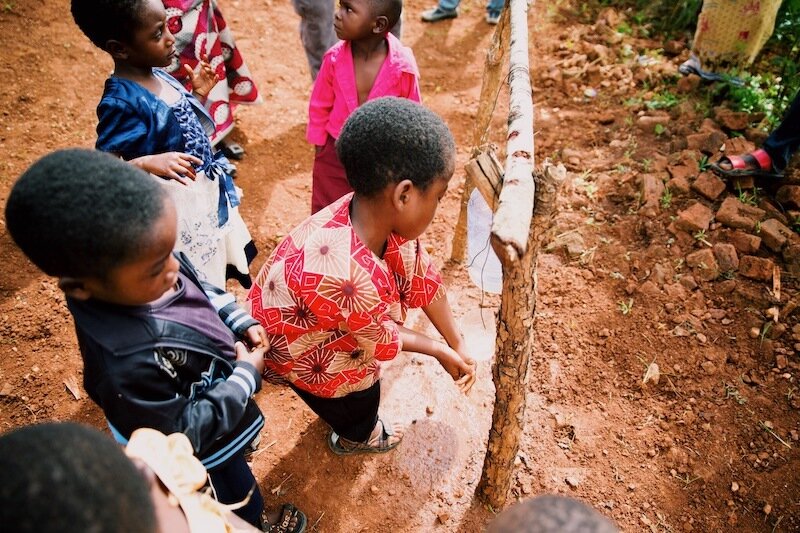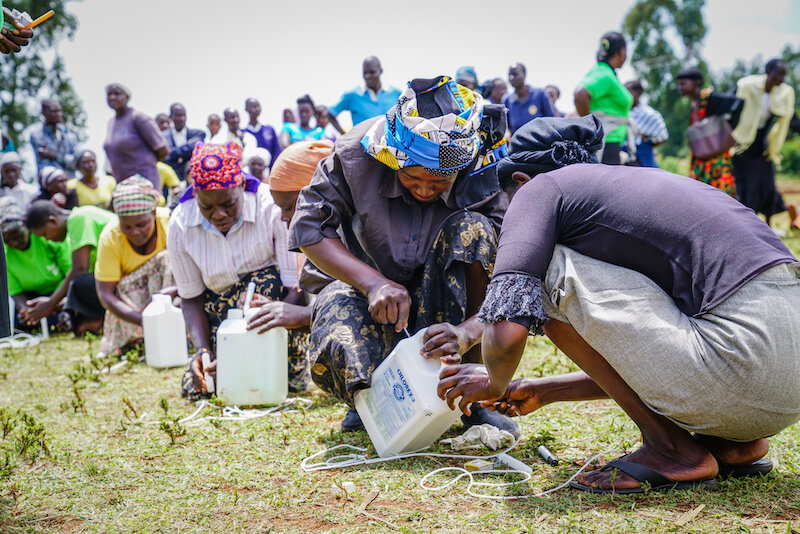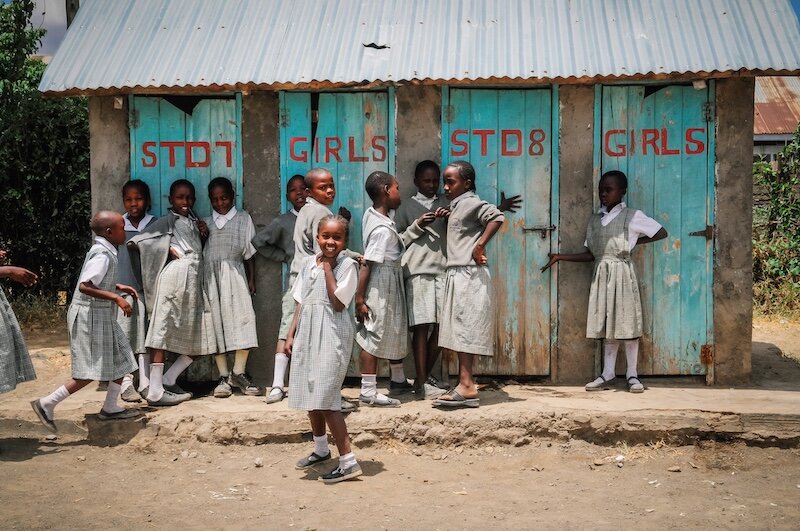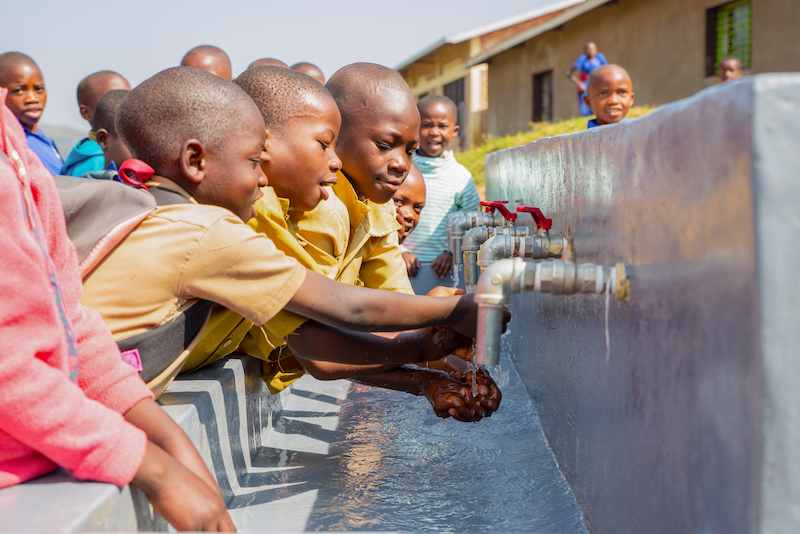To celebrate the importance of World Toilet Day on November 19 and as part of our ongoing series from our Africa Programs team on how our partners measure the success of their community health projects,
here’s a look into how they count sanitation and hygiene facilities, an essential part of keeping communities and water sources safe and clean. Access to clean water, sanitation, and hygiene (WASH) are essential parts of our mission, and with our partners, we are working to provide these resources to as many people as we can… for good.
WHY DO HYGIENE AND SANITATION MATTER?
Water is obviously essential to life, and something that all too many in sub-Saharan Africa don’t have healthy access to. We talk a lot about the importance of WASH as a whole, how water sources can easily be contaminated if community members don’t understand the importance of sanitation and hygiene, bringing them right back to where they started. The intervention of proper sanitation facilities and practices takes the health benefits of clean water from around 30% improvement to nearly 75% when combined.
As Dan explains in his blog on the subject, “WASH represents the fullness of water intervention in a community that has struggled to gain access to this most basic building block of healthy life… It is also a key differentiator between water projects that will have a mild to negligible health impact vs. a water project that will have a robust and lasting health impact on a community.”
The Global Context
After learning from the benefits and shortcomings of the UN Millennium Development Goals, the world adopted the UN Sustainable Development Goals in 2015, which all of our partners’ countries ascribe to, setting relevant targets for change in developing countries by 2030. Specific to WASH, the goals are to:
-
Achieve adequate and equitable access to sanitation and hygiene for all and end open defecation, paying special attention to the needs of women and girls
-
Ensure all men and women, have access to basic services including safe and affordable drinking water, and adequate and equitable sanitation and hygiene
When these goals were made, 39% of the global population used a safely managed sanitation service, and 68% had access to at least a basic sanitation service, however almost every country in sub-Saharan Africa had less than 50% coverage of even basic sanitation services. Coverage of basic hand washing services was lowest in parts of sub-Saharan Africa at 15%.
For more about how our work addresses these goals, you can see our blog about how our partners address ten out of the 17 goals in various capacities.
MEASURING SUCCESS OF WASH PROJECTS
All of our partners are vetted professional experts, local to the areas in which they work, so that they understand their community’s needs, and stay involved after the projects are complete. This ensures that implemented projects last longer than they would have if people without insider knowledge installed a solution that wasn’t beneficial or understood by the community. Plus they involve local people in planning and implementing programs so they can continue this work after the partner leaves, take their families’ futures into their own hands, and create change for generations to come.
As we’ve reported before, there is more to tracking the success of projects than you may outwardly think. Our partners follow globally accepted standards in collecting data and measuring project impact so that they can be sure they are helping communities as much as they can.
For water, they follow Sphere Standards, a set of holistic monitoring requirements for creating sustainable change, reporting every quarter on 52 indicators for a total of 171 data points and outputs. For example, they keep track of things like distance from a water source, number of family members in a household, and how long someone waits in line to retrieve water. By tracking each of these things, we can get a clearer picture of the community’s situation and needs.
Indicators
The first WASH indicator we’ll look at is the “number of new hygiene facilities constructed, or rehabilitated, by type.” This means that the completion of the building or fix-up was within the specific reporting period, regardless of when it was started or when most of the work was done. Hygiene facilities are primarily:
-
handwashing stations with soap and water
-
private bathing facilities for no more than 50 people if for the whole community
-
dish drying racks, and
-
garbage pits
The next indicator is the “number of functional latrines constructed or rehabilitated, by type.” Latrines are defined as a door with a pit that immediately contains excreta with a barrier between people and waste. If it’s a system with multiple stalls, the number of latrines equals the number of doors (e.g. a block of four doors/stalls is considered four latrines), although it should still be noted whether they are part of one block of stalls or separate. These new latrines are counted in the quarter that they are first usable by the community.
There are a lot more standards that latrines must follow in order to be considered adequate, and all latrines must have a handwashing station.
-
For a community, there should be one latrine per every fifty people, or one per twenty people if for a single family.
-
For households, there must be one latrine per family at a maximum of fifty meters from the home at least thirty meters from the water source.
-
For schools, the requirement is a maximum of fifty males per door can use a urinal, twenty females at most per door, and at least one latrine each for male and female staff, all at a maximum of fifty meters from the school.
-
Health centers must have at least one latrine for twenty beds or fifty outpatients at a maximum of fifty meters from the facility.
Most latrines are going to be simple pit latrines, ventilated improved pit latrines, composting latrines, or pour flush latrines. You can read more about the difference between these technologies and how they work here. Our partners also measure the “number of individuals with access to improved sanitation facilities,” noting how many are male and female.
How We’ve Done
Historically, Blood:Water partners have established 38,418 hygiene and sanitation facilities, through June 2021, including 10,705 latrines and a little over 29,000 hygiene facilities. Most of the data comes from the past five years, partially because we started using our current indicator matrix and how we now focus more on the holistic integration of WASH.
Due to COVID-19, hygiene facilities have become an even higher priority for all of our partners. Since the start of the pandemic, our partners have established 1,686 hygiene facilities for COVID-19 prevention and control, reaching 9,909 households and 714,625 individuals!
Beyond clean water, these facilities create indescribable changes beyond what we can ever truly know, and our partners make sure the vital practices associated with sanitation and hygiene spread to every one possible through vehicles like community-wide training and mobilization of community health workers.
For every water point established in a community, our partners also develop a WASH committee that teaches essential sanitation and hygiene principles to community members. Once someone knows this information, they can spread it to their neighbors, family, friends, church members, and so on! This is simple knowledge to many of us who grew up with it, but it will aid communities for generations to come.
HYGIENE AND SANITATION IN PRACTICE FOR ONE GIRL
Sandrah Kemirembe is a 13-year-old student attending Denis Centre Primary School in Mityana, Uganda, who wants to be a flight attendant when she grows up. When PaCT (our partner in the country) came to Sandrah’s school, they constructed a spring-protected well, providing clean and safe water not only to the students at Denis Centre, but also to the surrounding community.
However, PaCT knew that access to safe water was not enough (see our profile on their Executive Director Geoffrey, one of the 2021 recipients of our Leader of the Year Award); community members also needed to understand the importance of sanitation and hygiene in order to truly be free from waterborne diseases. So in addition to constructing the well, PaCT also formed a WASH club at the school.
Sandrah is a member of this club, and she loves caring for people, including her fellow students and teachers. There, Sandrah teaches her fellow students about proper sanitation and hygiene, including menstrual hygiene management, like wearing pads, washing underwear and uniforms, and staying clean. She works hard to keep her fellow students healthy, also ensuring that the kitchens, bathrooms, and dormitories are clean since she understands that proper sanitation and hygiene is integral to health.
She says of this work, “At this school I can help girls in their menstruation period. Help them [know]… how to wash, how to wear their pads, or how to wash their knickers as well. And I can help young ones to wash their uniforms, to clean themselves, and they can help the club that’s here on duty to clean the compound. I can work with them in the kitchen. I can make sure that the kitchen is very well-cleaned. Our latrines, they are clean… I can make sure that the dormitories are clean. I can make sure the plates of the teachers are clean very well. The teachers, have they eaten very well? Are they healthy? That’s my duty at this school.”
“It’s very important because I can gain… kind of create friendships among my fellow people… It can create love between me and my teachers… It’s a good cause to care for [others]. It makes you feel good as well. Someone [who] is clean, is healthy.”
More Stories:
Categories






